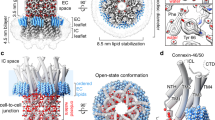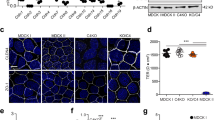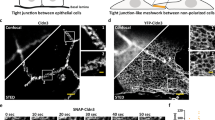Abstract
We examine here the proposition that membrane lipids1–4, rather than intrinsic membrane proteins5–7, are the principal structural elements of the strands comprising tight junctions. Our evidence, which is based on direct rapid freezing of newly formed tight junctions between rat prostate epithelial cells, indicates that individual tight junction strands are pairs of inverted cylindrical micelles sandwiched between linear fusions of the external membrane leaflets of adjacent cells. Although individual tight junction strands appear as continuous cylinders when fractured near the frozen surface, where ice crystals have not damaged the plasma membrane, they appear as rows of particles when fractured deeper in the frozen tissue. We now interpret these tight junction particles as remnants of intramembrane cylinders disrupted during freezing The morphology and dimensions of the intact cylinders correspond to those of lipids in the cylindrical hexagonal II phase8,9 and this suggests that tight junction formation requires a phase transition of the planar lipid bilayer similar to that invoked in models of membrane fusion10,11. Our morphological interpretation explains the known functional properties of tight junctions.
This is a preview of subscription content, access via your institution
Access options
Subscribe to this journal
Receive 51 print issues and online access
$199.00 per year
only $3.90 per issue
Buy this article
- Purchase on Springer Link
- Instant access to full article PDF
Prices may be subject to local taxes which are calculated during checkout
Similar content being viewed by others
References
Verkleij, A. J. Proc. Electron Microsc. Soc. Am. 38, 688–691 (1980).
Kachar, B. & Pinto da Silva, P. Science 213, 541–544 (1981).
Kachar, B. & Reese, T. S. J. Cell Biol. 91, 123a (1981).
Pinto da Silva, P. & Kachar, B. Cell (in the press).
Staehelin, L. A. Int. Rev. Cytol. 39, 191–283 (1974).
Bullivant, S. in Electron Microscopy IX (ed. Sturgess, J. M.) 659–672 (Microscopical Society of Canada, Toronto, 1978).
Van Deurs, B. & Luft, J. H. J. ultrastruct. Res. 68, 160–172 (1979).
Deamer, D. W., Leonard, R., Tardieu, A. & Branton, D. Biochim. biophys. Acta 219, 47–60 (1970).
Rand, R. P. & Sengupta, S. Biochim. biophys. Acta 255, 484–492 (1979).
Cullis, P. R. & Hope, M. J. Nature 271, 672–674 (1978).
Verkleij, A. J., Mombers, C., Gerritsen, W. J., Lennissen-Bijvelt, L. & Cullis, P. R. Biochim. biophys. Acta 555, 358–361 (1979).
Staehelin, L. A. J. Cell Sci. 13, 763–786 (1973).
Montesano, R., Friend, D. S., Perrelet, A. & Orci, L. J. Cell Biol. 67, 310–319 (1975).
Simionescu, M. & Simionescu, N. J. Cell Biol. 74, 98–110 (1977).
Montesano, R. Anat. Rec. 198, 403–414 (1980).
Weinbaum, S. J. theor. Biol. 83, 63–92 (1980).
Heuser, J. E. et al. J. Cell Biol. 81, 275–300 (1979).
Wade, J. B. & Karnovsky, M. J. J. Cell Biol. 60, 168–180 (1974).
Verkleij, A. J. & Ververgaert, P. Biochim. biophys. Acta 515, 303–327 (1978).
Verkleij, A. J., Mombers, C., Lennissen-Bijvelt, Y. & Ververgaert, P. Nature 279, 162–163 (1979).
DeKruijff, B. Biochim. biophys. Acta 555, 200–209 (1973).
Miller, R. G. Nature 287, 166–167 (1980).
Rand, R. P., Reese, T. S. & Miller, R. G. Nature 293, 237–238 (1981).
Sen, A., Williams, W. P., Brain, A. P. R., Dickens, M. J. & Quinn, P. J. Nature 293, 488–490 (1981).
Hui, S. W., Stewart, T. P., Yeagle, P. L. & Albert, A. D. Archs Biochem. Biophys. 207, 227–240 (1981).
Cullis, P. R. & DeKruijff, B. Biochim. biophys. Acta 559, 399–420 (1979).
Parsegian, V. A., Fuller, N. & Rand, R. P. Proc. natn. Acad. Sci. U.S.A. 76, 2750–2754 (1979).
Meza, I., Ibarra, G., Sabanero, M., Martinez-Palomo, A. & Cereijido, M. J. Cell Biol. 87, 746–754 (1980).
Brightman, M. W. & Reese, T. S. J. Cell Biol. 40, 648–677 (1969).
Friend, D. S. & Gilula, N. B. J. Cell Biol. 53, 758–776 (1972).
Dragsten, P. R., Blumenthal, R. & Handler, J. S. Nature 294, 718–722 (1981).
Author information
Authors and Affiliations
Rights and permissions
About this article
Cite this article
Kachar, B., Reese, T. Evidence for the lipidic nature of tight junction strands. Nature 296, 464–466 (1982). https://doi.org/10.1038/296464a0
Received:
Accepted:
Issue Date:
DOI: https://doi.org/10.1038/296464a0
This article is cited by
-
The intestinal epithelial barrier: a therapeutic target?
Nature Reviews Gastroenterology & Hepatology (2017)
-
Tight junctions: from simple barriers to multifunctional molecular gates
Nature Reviews Molecular Cell Biology (2016)
-
Tight junction-based epithelial microenvironment and cell proliferation
Oncogene (2008)
-
A porous defense: the leaky epithelial barrier in intestinal disease
Laboratory Investigation (2004)
Comments
By submitting a comment you agree to abide by our Terms and Community Guidelines. If you find something abusive or that does not comply with our terms or guidelines please flag it as inappropriate.



